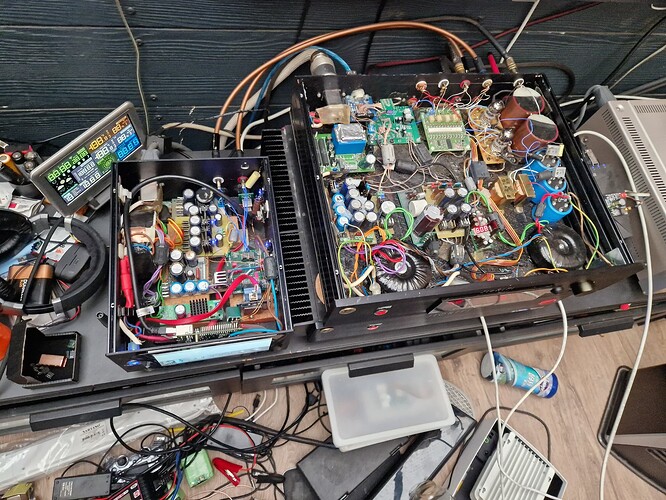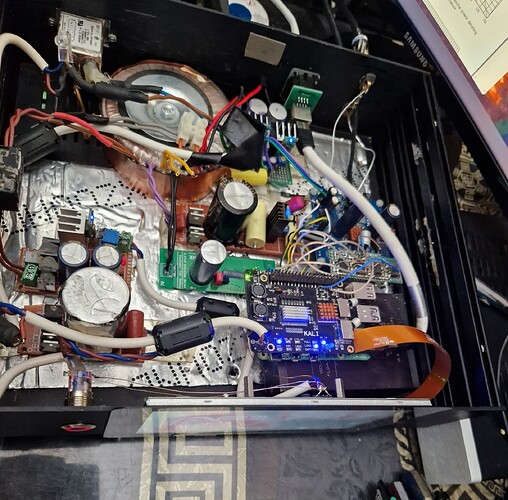Vacation started and what a better way than taking the soldering iron in use. Now, i did some experimenting and to my surprise the sound is quite better using USB trough an XMOS xCORE-200 than using I2S. I2S was also tested through isolators (better) and the Kali (worse). Others that can share some experiences?
Here I experience it the other way around, i2s better.
I’m also getting older and probably can’t hear everything very well anymore.
Hi,
You know my opinion:
On Volumio if you want to hear music you need Pi5 with program and DAC which convert digital to analog. And here we all agree. Here we talk about few different things because:
I2S is a signal protocol and USB is a bus. At the end of signal road DAC gets i2s anyway. In this situation
it doesn’t make sense because we all have I2s ![]()
Difference is how you get I2s signal. I’m not programist but if you want use I2s signal from RPi you use module that is only a regular linux kernel module. It is software.
If you use USB module like XMOS, you send data from RPi asynchronously to the device and it creates i2s on its own processor - there is no preemption and the device works in loop 1 of the task.
Do you see where is difference ?? RPi is computer. XMOS is specialistic device made only to create I2s signal.
I’m referring to this, USB vs i2s.
But in this article, they sent USB and I2s signal from the same device, Gustard or Singxer. Both are specialistic XMOS device and give you perfect I2s signal.
Here on RPi is not the same situation. Here is question: better is send via USB asynchronusly data to special XMOS device which prepare for DAC perfect I2S … or use RPi to send some I2s signal for DAC.
I can honestly say that I have a good system. You can hear the SPDIF cable being changed to another one. The sound from I2s HAT is incomparably weaker than when the RPi sends the signal via USB to the converter. Analyticality, holography, depth of the music scene, treble detail, etc.
The ears of a person playing in a philharmonic hall and a sound engineer do not lie. Both solution were testet on persons above ![]()
I’m not saying that you will find a difference in every system, but we talked about this with the DAC for USD 4k.
Trust me, if you had a $30k - 50k audio system you wouldn’t want to use a HAT.
NIce article but not to the point as the dac is always connecting to I2S. The thing is how good is the PI to do I2S compared to for example XMOS.
I do understand that, and it makes perfect sense. Was wondering of other people’s experience in the topic as theory is one thing, what we hear is something else.
I agree, this is a point of this talk.
Kernel process vs hardware process.
On R Pi up to V4 there are issues with the USB output, that is why I2S is traditionally preferred.
I guess the point is that if you want to compare, test apples to apples. If it’s audible, it’s measurable.
Get a DAC that has an I2S and USB input and flip between/measure. Provided, from an audible perspective, everything is level matched, if there’s any difference, it should be able to be seen.
If you want to see WHY you can hear a difference, that will give you the answer.
Really nice answer indeed. Besides the measurement we are there. I have no means to measure as this will require a spectrum analyzer in order to get something useful.
But the dac is the same, ES9028Pro - a modified DIYINHK board, all linear supplies, external clock etc.
Now, I2S direct to dac compared to xmos to dac the score is 0-1 sound wise.
Rest of the setup, you can see in the picture, tube buffered Pre, duelund output caps etc etc, towards KEF reference 201.2 speakers. I believe the setup is very revieling
Yet another test on my test volumio, Pi5, all linear supplies, difference this is an AK dac so Kali needs to be used to get the clock signals. Kali modified with better clocks. Same conclusion but not as much difference as with the ES, USB through XMOS sounds better in my ears.
You are not alone ![]()
I compared it on my Ayon Triton with KT150 amplifier connected to Martin Logan CLS. My DAC is based on STAX Talent with parallel PCM63K. Digital side is changed and tuned by me ( filters, power supply ) and analog side is made by me:
This setup is really transparent and difference beetwen HAT’s vs USB card is gigantic.
To hear the difference - the system matters.
I love it when people do things them selfs:) Nice job man!
I have tubes on my pre, driving FETS on the output stage, output stage battery driven, 10*12V batteries. Only problem i destroyed a couple of IKEA selves because of the weight. LOL:)
I know something about it. My amp weight 50 kg, my TT about 15 kg, DAC and Volumio next few kg ![]()
Its burglary safe. Nobody can run with it:)
I know, it is joke ![]() World is changing. People starts listen music not bits. Depth and resolution is good only on paper. I never heard Delta Sigma with better sound than old R2R in good application. It’s not only my opinion. I have few customer from Europe. They bouhgt my DACs based on PCM or TDA1541 to put it on 100 k and more EURO systems. I made about 8 DACs in year to Germany and Switzerland. My DACs replaced DCS, Golden Gate Lampizator and many more top DACs. I not try to said that do better DACs but with another sound compared to ESS and WM. (I know it is not a topic about this)
World is changing. People starts listen music not bits. Depth and resolution is good only on paper. I never heard Delta Sigma with better sound than old R2R in good application. It’s not only my opinion. I have few customer from Europe. They bouhgt my DACs based on PCM or TDA1541 to put it on 100 k and more EURO systems. I made about 8 DACs in year to Germany and Switzerland. My DACs replaced DCS, Golden Gate Lampizator and many more top DACs. I not try to said that do better DACs but with another sound compared to ESS and WM. (I know it is not a topic about this)
I believe you, its on my bucket list, to get my fingers on a R2R dac. New implementations seem quite interesting too. The ones with resistor ladders l mean.
Denafrips ares ii gets good reviews.


